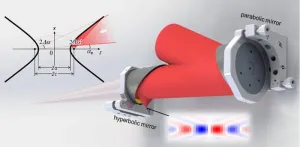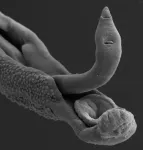(Press-News.org) One of the great mysteries of modern science is dark matter. We know dark matter exists thanks to its effects on other objects in the cosmos, but we have never been able to directly see it. And it’s no minor thing—currently, scientists think it makes up about 85% of all the mass in the universe.
A new experiment by a collaboration led by the University of Chicago and Fermi National Accelerator Laboratory, known as the Broadband Reflector Experiment for Axion Detection or BREAD, has released its first results in the search for dark matter in a study published in Physical Review Letters. Though they did not find dark matter, they narrowed the constraints for where it might be and demonstrated a unique approach that may speed up the search for the mysterious substance, at relatively little space and cost.
“We’re very excited about what we’ve been able to do so far,” said UChicago Assoc. Prof. David Miller, co-leader for the experiment alongside Fermilab’s Andrew Sonnenschein, who originally developed the concept for the experiment. “There are lots of practical advantages to this design, and we’ve already shown the best sensitivity to date in this 11-12 gigahertz frequency.”
“This result is a milestone for our concept, demonstrating for the first time the power of our approach,” said Fermilab postdoctoral scholar and study lead author Stefan Knirck, who spearheaded the construction and operation of the detector. “It is great to do this kind of creative tabletop-scale science, where a small team can do everything from building the experiment to data analysis, but still have a great impact on modern particle physics.”
‘Something is there’
When we look around the universe, we can see that some kind of substance is exerting enough gravity to pull on stars and galaxies and passing light, but no telescope or device has ever directly picked up the source—hence the name ‘dark matter.’
However, because no one has ever seen dark matter, we don’t even know exactly what it might look like or even precisely where to look for it. “We’re very confident that something is there, but there are many, many forms it could take,” said Miller.
Scientists have mapped out several of the most likely options for places and forms to look. Typically, the approach has been to build detectors to very thoroughly search one specific area (in this case, set of frequencies) in order to rule it out.
But a team of scientists explored a different approach. Their design is “broadband,” meaning that it can search a larger set of possibilities, albeit with slightly less precision.
“If you think about it like a radio, the search for dark matter is like tuning the dial to search for one particular radio station, except there are a million frequencies to check through,” said Miller. “Our method is like doing a scan of 100,000 radio stations, rather than a few very thoroughly.”
A proof of concept
The BREAD detector searches for a specific subset of possibilities. It’s built to look for dark matter in the form of what are known as “axions” or “dark photons”— particles with extremely small masses that could be converted into a visible photon under the right circumstances.
Fermilab's Stefan Knirck with components of the BREAD detector.
Thus, BREAD consists of a metal tube containing a curved surface that catches and funnels potential photons to a sensor at one end. The entire thing is small enough to fit your arms around, which is unusual for these types of experiments.
In the full-scale version, BREAD will be settled inside a magnet to generate a strong magnetic field, which ups the chances of converting dark matter particles into photons.
For the proof of principle, however, the team ran the experiment sans magnets. The collaboration ran the prototype device at UChicago for about a month and analyzed the data.
The results are very promising, showing very high sensitivity in the chosen frequency, the scientists said.
Since the results published in Physical Review Letters were accepted, BREAD has been moved inside a repurposed MRI magnet at Argonne National Laboratory and is taking more data. Its eventual home, at Fermi National Accelerator Laboratory, will use an even stronger magnet.
“This is just the first step in a series of exciting experiments we are planning,” said Sonnenschein. “We have many ideas for improving the sensitivity of our axion search.”
“There are still so many open questions in science, and an enormous space for creative new ideas for tackling those questions,” said Miller. “I think this is a really hallmark example of those kind of creative ideas—in this case, impactful, collaborative partnerships between smaller-scale science at universities and larger-scale science at national laboratories.”
The BREAD instrument was built at Fermilab as part of the laboratory’s detector R&D program and then operated at UChicago, where the data for this study were collected. UChicago Ph.D graduate student Gabe Hoshino led the operation of the detector, along with undergraduate students Alex Lapuente and Mira Littmann.
Argonne National Laboratory maintains an important magnet facility that will be used for the next stage of the BREAD physics program. Other institutions, including SLAC National Accelerator Laboratory, Lawrence Livermore National Laboratory, Illinois Institute of Technology, MIT, the Jet Propulsion Laboratory, the University of Washington, Caltech, and the University of Illinois at Urbana-Champaign, are working with UChicago and Fermilab on R&D for future versions of the experiment.
Citation: “First Results from a Broadband Search for Dark Photon Dark Matter in the 44 to 52 μeV Range with a Coaxial Dish Antenna.” Knirck et al, Physical Review Letters, March 28, 2024.
Funding: U.S. Department of Energy Office of Science, University of Chicago Joint Task Force Initiative, Cambridge Junior Research Fellowship, Kavli Institute for Particle Astrophysics and Cosmology Porat Fellowship.
END
First results from BREAD experiment demonstrate a new approach to searching for dark matter
UChicago, Fermilab research uses coaxial “dish” antenna to scan for mysterious particles
2024-04-02
ELSE PRESS RELEASES FROM THIS DATE:
Focusing ultra-intense lasers to a single wavelength
2024-04-02
Ultra-intense ultrashort lasers are powerful tools used in various fields like physics, national security, industry, and healthcare. They help researchers delve into strong-field laser physics, laser-driven radiation sources, particle acceleration, and more.
“Peak power” measures the intensity of these lasers, like the Nova laser (Lawrence Livermore National Laboratory, California, USA) with 1.5 petawatts of peak power, the Shanghai Super-intense Ultrafast Laser Facility (SULF, China) with 10 petawatts, or the Extreme Light Infrastructure – Nuclear Physics (ELI-NP, Romania) with a peak ...
Combining food taxes and subsidies can lead to healthier grocery purchases for low-income households
2024-04-02
Chapel Hill, NC, April 2, 2024 — A new study that models the combined effects of a sugar-based tax on beverages and targeted subsidies for minimally processed foods and drinks found that under these policies, low-income consumers would purchase less sugar-sweetened beverages and more fruits, vegetables, and healthier drinks, particularly in households without children.
Researchers at the University of North Carolina at Chapel Hill developed a model to simulate what would happen if national-level taxes on less-healthy, ...
One in five people with cancer participate in medical research studies
2024-04-02
SEATTLE – April 2, 2024 – Researchers from Fred Hutchinson Cancer Center, the American Cancer Society Cancer Action Network and peer institutions released new findings in the Journal of Clinical Oncology showing that when all types of cancer research studies are considered, at least one in five people with cancer, or 21.9%, participate in some form of clinical research.
The study evaluated all categories of cancer studies, such as treatment trials, biorepository studies and quality of life studies—the first time an estimate of participation in all types of cancer ...
Sunrise to sunset, new window coating blocks heat — not view
2024-04-02
Windows welcome light into interior spaces, but they also bring in unwanted heat. A new window coating blocks heat-generating ultraviolet and infrared light and lets through visible light, regardless of the sun’s angle. The coating can be incorporated onto existing windows or automobiles and can reduce air-conditioning cooling costs by more than one-third in hot climates.
“The angle between the sunshine and your window is always changing,” said Tengfei Luo, the Dorini Family Professor for Energy Studies at the University of Notre ...
Innovative molecular biology technique allows for discovery of novel targets for candidate vaccines against schistosomiasis
2024-04-02
Researchers in Brazil have used an innovative technique in molecular biology to identify targets for candidate vaccines against Schistosoma mansoni, the parasite that causes schistosomiasis.
Considered one of the world’s 17 neglected tropical diseases (NTDs), schistosomiasis affects some 200 million people in 74 countries, according to the World Health Organization (WHO). Six million are estimated to be infected in Brazil, mainly in the Northeast region and Minas Gerais state.
The scientists used phage display, the study of protein interactions using bacteriophages, viruses that infect bacteria, to screen 99.6% of 119,747 DNA sequences encoding the proteins known ...
Study finds Netflix misses the mark by trivializing teenagers’ pain
2024-04-02
UCalgary led study finds Netflix misses the mark by trivializing teenagers’ pain. Findings are published in PainResearchers at the University of Calgary and the University of Bath, U.K., are calling on Netflix to do a better job of representing the kind of pain typically experienced by 12-to-18-year-olds. A new study finds the streaming channel should not emphasize stereotypes, like the heroic, stoic boy and the helpless, emotional girl who requires his rescue and prioritizes his pain and suffering.
“Media ...
TLI investigator Dr. Denise Al Alam receives $1.5 million grant from CIRM to explore genetic defects of lung disease in Down Syndrome
2024-04-02
The Lundquist Institute for Biomedical Innovation at Harbor-UCLA Medical Center (TLI) today announced that The California Institute for Regenerative Medicine (CIRM), one of the world’s largest institutions dedicated to regenerative medicine, has
awarded $1.5 million to TLI Investigator Denise Al Alam, PhD, to support research that aims to understand lung disease in individuals with Trisomy 21 (also known as Down Syndrome). Although Trisomy 21 impacts multiple organ systems, respiratory complications are a significant cause of death in children and adults with this genetic condition.
With the highest occurrence of Down Syndrome births in California within the Latinx ...
Increasing positive affect in adolescence could lead to improved health and well-being in adulthood
2024-04-02
Adolescents with high positive affect may have improved physical and mental health as adults, according to a study published April 2nd in the open-access journal PLOS Medicine by Eric Kim and Renae Wilkinson from Harvard University, US, and colleagues.
Positive affect is the experience of pleasurable emotions, such as happiness, joy, excitement, and calm. Research on adults has shown that positive affect is associated with healthier behaviors and decreased risk of chronic diseases, but data are limited in adolescents. Given that adolescence is a critical ...
Methods sections often lack critical details needed to reproduce an experiment, and the practice of citing previous papers instead of describing the methods in detail may contribute to this problem
2024-04-02
Methods sections often lack critical details needed to reproduce an experiment, and the practice of citing previous papers instead of describing the methods in detail may contribute to this problem
Analysis of >750 papers shows that >90% of papers use at least one shortcut citation, that these significantly impair reconstruction of the original method, and that <25% of journals have policies relating to previously described methods
#####
In your coverage, please use this URL to provide access to the freely available paper in PLOS ...
Study: AI writing, illustration emits hundreds of times less carbon than humans
2024-04-02
LAWRENCE — With the evolution of artificial intelligence comes discussion of the technology's environmental impact. A new study has found that for the tasks of writing and illustrating, AI emits hundreds of times less carbon than humans performing the same tasks. That does not mean, however, that AI can or should replace human writers and illustrators, the study’s authors argue.
Andrew Torrance, Paul E. Wilson Distinguished Professor of Law at KU, is co-author of a study that compared established systems such as ChatGPT, Bloom AI, DALL-E2 and others completing writing and illustrating to that of humans.
Like ...
LAST 30 PRESS RELEASES:
Why some brains switch gears more efficiently than others
UVA’s Jundong Li wins ICDM’S 2025 Tao Li Award for data mining, machine learning
UVA’s low-power, high-performance computer power player Mircea Stan earns National Academy of Inventors fellowship
Not playing by the rules: USU researcher explores filamentous algae dynamics in rivers
Do our body clocks influence our risk of dementia?
Anthropologists offer new evidence of bipedalism in long-debated fossil discovery
Safer receipt paper from wood
Dosage-sensitive genes suggest no whole-genome duplications in ancestral angiosperm
First ancient human herpesvirus genomes document their deep history with humans
Why Some Bacteria Survive Antibiotics and How to Stop Them - New study reveals that bacteria can survive antibiotic treatment through two fundamentally different “shutdown modes”
UCLA study links scar healing to dangerous placenta condition
CHANGE-seq-BE finds off-target changes in the genome from base editors
The Journal of Nuclear Medicine Ahead-of-Print Tip Sheet: January 2, 2026
Delayed or absent first dose of measles, mumps, and rubella vaccination
Trends in US preterm birth rates by household income and race and ethnicity
Study identifies potential biomarker linked to progression and brain inflammation in multiple sclerosis
Many mothers in Norway do not show up for postnatal check-ups
Researchers want to find out why quick clay is so unstable
Superradiant spins show teamwork at the quantum scale
Cleveland Clinic Research links tumor bacteria to immunotherapy resistance in head and neck cancer
First Editorial of 2026: Resisting AI slop
Joint ground- and space-based observations reveal Saturn-mass rogue planet
Inheritable genetic variant offers protection against blood cancer risk and progression
Pigs settled Pacific islands alongside early human voyagers
A Coral reef’s daily pulse reshapes microbes in surrounding waters
EAST Tokamak experiments exceed plasma density limit, offering new approach to fusion ignition
Groundbreaking discovery reveals Africa’s oldest cremation pyre and complex ritual practices
First breathing ‘lung-on-chip’ developed using genetically identical cells
How people moved pigs across the Pacific
Interaction of climate change and human activity and its impact on plant diversity in Qinghai-Tibet plateau
[Press-News.org] First results from BREAD experiment demonstrate a new approach to searching for dark matterUChicago, Fermilab research uses coaxial “dish” antenna to scan for mysterious particles





